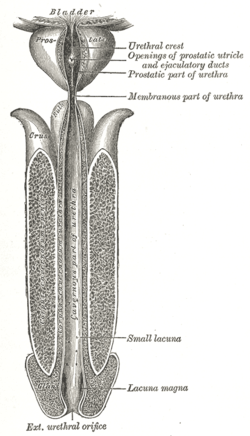In male anatomy, the lacuna magna (also called Guérin's sinus) is the largest of several recesses in the roof of the navicular fossa of the male urethra.
| Lacuna magna | |
|---|---|
 The male urethra laid open on its anterior (upper) surface, lacuna magna labeled near the glans penis (bottom). | |
| Details | |
| Identifiers | |
| Latin | lacuna magna |
| Anatomical terminology | |
Structure
editThe lacuna magna is a large recess in the roof of the navicular fossa of the male urethra.[1]
Development
editThe embryological origin of the lacuna magna is contested.[2] However, recent evidence suggests it and the navicular fossa of the male urethra derive from infiltrating endodermal cells of the urethral plate.[2]
Clinical significance
editIn young males, the presence of the lacuna magna is associated with painful urination (dysuria), bloody urine (hematuria), and bloody spotting of underwear.[3][4]
References
edit- ^ Shenoy, Sunil P.; Marla, Prashanth K.; Venugopal, P.; Adappa, Karunakara K.; Tantry, Trivikrama Padur; Shankar, Murali; Rai, Guruprasad D. (2011-11-01). "An Endoscopic Study of the Lacuna Magna and Reappraisal of Its Clinical Significance in Contemporary Urological Practice". Urology. 78 (5): 1009–1015. doi:10.1016/j.urology.2011.05.013. ISSN 0090-4295. PMID 21777960.
- ^ a b Kurzrock E, Baskin L, Cunha G (1999). "Ontogeny of the male urethra: theory of endodermal differentiation". Differentiation. 64 (2): 115–22. doi:10.1046/j.1432-0436.1999.6420115.x. PMID 10234808.
- ^ Bellinger M, Purohit G, Duckett J, Cromie W (1983). "Lacuna magna: a hidden cause of dysuria and bloody spotting in boys". J. Pediatr. Surg. 18 (2): 163–6. doi:10.1016/S0022-3468(83)80542-9. PMID 6854496.
- ^ Sommer J, Stephens F (1980). "Dorsal urethral diverticulum of the fossa navicularis: symptoms, diagnosis and treatment". J. Urol. 124 (1): 94–7. doi:10.1016/s0022-5347(17)55312-4. PMID 7411733.